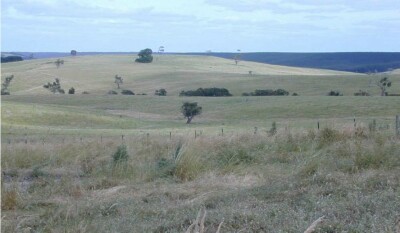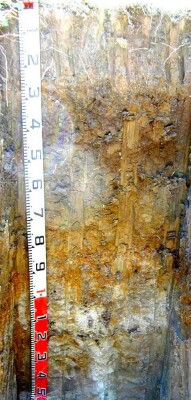ASH98 (plot 4)
| Site: ASH98 (Plot 4) | Land Unit: Digby |
 |
|
Site Description:
| Geology: Cretaceous non-marine sandstone | Landform pattern: Undulating plain |
| Internal drainage: Imperfectly drained |
Soil Profile Morphology
| A1 | 0-30 cm | Dark brown (10YR3/3) clay loam; weak polyhedral structure (20-50 mm) parting to weak granular structure (5-10 mm); very weak consistence when dry; very few medium ferruginous nodules; many very fine macropores; areal porosity 0.2%; many medium roots; abrupt and smooth transition to: |  |
| Subsoil | |||
| B21 | 30-60 cm | Yellowish brown (10YR5/4), medium clay; weak polyhedral structure (20-50 mm); firm consistence when moderately moist; common very fine macropores; areal porosity 0.08%; few very fine roots; diffuse and smooth transition to: | |
| B22 | 60-90 cm | Yellowish brown (10YR5/4) with many medium faint yellowish brown (10YR5/6) mottles, medium heavy clay; weak polyhedral structure (20-50 mm); firm consistence when moderately moist; common very fine macropores; areal porosity 0.08%; few very fine roots; clear and smooth transition to: | |
| B3 | 90-115 cm | Light brownish grey (10YR6/2) with many coarse distinct yellowish brown (10YR5/6) and brownish yellow (10YR6/8) mottles, medium heavy clay; moderate polyhedral structure (20-50 mm) parting to moderate polyhedral structure (10-20 mm); weak consistence when moderately moist; few coarse ferruginous nodules; few very fine macropores; areal porosity 0.5%; few very fine roots; clear and smooth transition to: | |
| C1 | 115-150 cm | Light brownish grey (10YR6/2) with common coarse prominent yellowish brown (10YR5/8) mottles, silty clay; massive structure; weak consistence when moderately moist; many very fine macropores; areal porosity 0.4%; few very fine roots. | |
| 150-210 cm | Fine sandy clay or clayey fine sand. | ||
| 210-310 cm | Grey Miocene mudstones, carbonaceous, live roots to 310 cm in cracks, appears to be an impeding layer although some roots are present. | ||
Notes: The Mudstone layer does not appear to offer a large water holding capacity.
Sampled by: Ian Sargeant, Paul Feikema and Martin Clark (6 December 2000)


